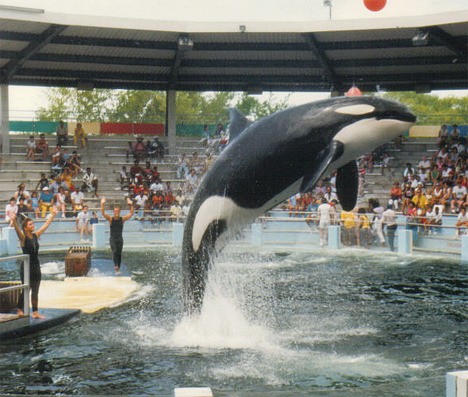A contingent of Friday Harbor orca advocates will participate in an international protest May 15 to call for a captive orca’s return to her native Salish Sea.
The international protest calls for the Miami Seaquarium to release Lolita, who was captured in Penn Cove 40 years ago. The protest begins at 9:30 a.m. Friday Harbor time. The regional coordinator is Debbi Fincher.
“We’ll be meeting at the bottom of Spring Street on May 15, 9:30 a.m. to noon, to show support for Lolita, the last surviving Southern resident orca left in captivity,” Fincher said. “Wear black and white that day or display something black and white to show your support for Lolita.”
More than 30 cities and countries have signed up to be part of the massive collaboration to show the Miami Seaquarium, along with other marine mammal parks and the world, that orcas do not belong in captivity, Fincher said. A protest held on Oct. 11, 2008 generated national media attention, resulting in a four-minute segment on CNN Headline News.
“In collaboration with Orca Network, we invite fellow residents and media to come out and support this cause,” Fincher said. “We hope to see Lolita retired back into a bay pen in her native Pacific Northwest waters where she will be taken care of for the rest of her life unless she chooses to rejoin her pod that lives there as well.”
Lolita’s captivity hits close to home for Fincher; she interned at the Seaquarium in the 1980s and remembers Lolita well. Fincher said Lolita’s pen is too small and is arguably unsafe.
“She has been living in an illegal tank at the Seaquarium for the last 39 years, and has taken a backseat to the newly developed swim-with-the-dolphins program. This backseat has raised controversy as to why she shouldn’t be retired, because the Seaquarium won’t build her a bigger tank. Surrounding the controversy with the rising number of orca attacks at Sea World, she could be the first of a new generation of orcas being retired back to their natural habitat.”
Proponents of Lolita’s release say the orca would initially reside in a bay pen, where she would be fed, taken care of and slowly reintroduced back into the wild. After rehabilitation, it would be her choice to continue to live in the bay pen or leave to rejoin her pod.
Fincher said advocates of Lolita’s release have offered more than what Lolita’s insurance policy is worth for her retirement, but Seaquarium owner Arthur Hertz has declined the offer.
Information on Lolita, Seaquarium conditions and the CNN Headline News interview can be found at www.orcanetwork.org. Visit www.savelolita.com for other information.
Shelby Proie is coordinator of the international protest: (412) 983-0994. E-mail Shelby@savelolita.com.
Contact Fincher at 378-9479 or fincher@rockisland.com.
Meanwhile, Orca Network is sponsoring a special protest in Coupeville as part of the international event. Orca Network e-mailed this information about its protest:
The “Lolita Come Home Campaign” is a major concern of Orca Network. Lolita, first called Tokitae, is the last surviving orca of 45 members of the Southern resident community that were captured and delivered for display in marine parks between 1965 and 1973. At least 13 others were killed during captures.
A young adult just over 40 years old, Lolita has been maintained at a Miami marine park since 1970. Only Corky at Sea World in San Diego, captured in 1969, has been in captivity longer.
Orca Network is inviting paddlers for a kayak (or canoe or rowboat) protest on Penn Cove at the capture site. Park at the DNR beach access just west of the Captain Whidbey Inn on Madrona Way, and launch about 5 p.m. when the tide is coming up. The idea is to paddle out to the actual scene of the capture, between the Captain Whidbey and the Penn Cove shellfish dock, with a banner or two on or between kayaks.
Signs, flags, bumper stickers, inflatable orcas, etc., can also be used, and if you don’t have a kayak, canoes or small boats are fine.
Depending on weather, time, and tides, we may also paddle to the Coupeville wharf, where an educational exhibit about the Penn Cove orca capture is displayed.
For more information, e-mail Howard@orcanetwork.org.




